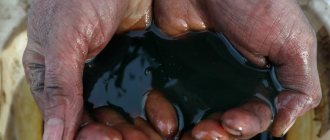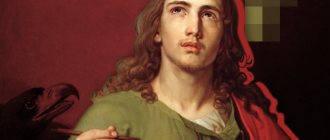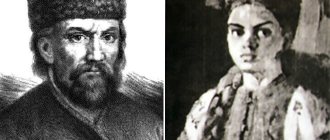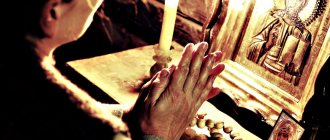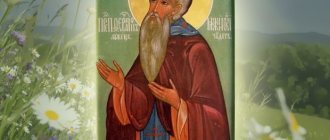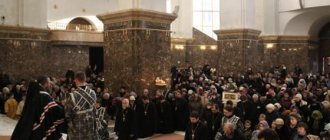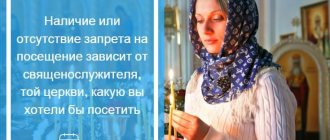After this, Jesus again appeared to His disciples at the Sea of Tiberias. He appeared like this: Simon Peter, and Thomas, who is called the Twin, and Nathanael from Cana of Galilee, and the sons of Zebedee, and two others of His disciples were together. Simon Peter says to them: I am going to fish.
They say to him: you and I are going too. They went and immediately got into the boat, and did not catch anything that night. And when morning had already come, Jesus stood on the shore; but the disciples did not know that it was Jesus.
Jesus says to them: children! do you have any food?
They answered Him: no.
He said to them: cast the net on the right side of the boat, and you will catch it. They cast, and could no longer pull out the nets from the multitude of fish.
Then the disciple whom Jesus loved said to Peter, “This is the Lord.” Simon Peter, hearing that it was the Lord, girded himself with clothing - for he was naked - and threw himself into the sea. And other disciples sailed in a boat - for they were not far from the land, about two hundred cubits - dragging a net with fish. When they came to the ground, they saw a fire laid out and fish and bread lying on it. Jesus says to them: Bring the fish that you have now caught.
Simon Peter went and brought down to the ground a net filled with large fish, of which there were one hundred and fifty-three; and with such a multitude the network did not break through. Jesus says to them: Come, have dinner. None of the disciples dared to ask Him: “Who are you?”, knowing that it was the Lord. Jesus comes, takes the bread and gives them fish as well.
This was the third time Jesus appeared to His disciples after His resurrection from the dead.
While they were having dinner, Jesus said to Simon Peter: Simon the Jonah! Do you love Me more than they?
Peter says to Him: Yes, Lord! You know I love you.
Jesus says to him: Feed my lambs. Another time he says to him: Simon the Jonah! do you love me?
Peter says to Him: Yes, Lord! You know I love you.
Jesus says to him: Feed My sheep. He says to him for the third time: Simon the Jonah! do you love me?
Peter was saddened that he asked him for the third time: “Do you love Me?”, and said to Him: Lord! You know everything; You know I love you.
Jesus says to him: Feed My sheep. Truly, truly, I say to you, when you were young, you girded yourself and went where you wanted; and when you are old, you will stretch out your hands, and another will gird you and lead you where you do not want to go. He said this, making it clear by what kind of death Peter would glorify God. And having said this, he said to him: follow me.
Peter, turning, sees the disciple following him, whom Jesus loved and who at the supper, bowing to His chest, said: “Lord! who will betray you? When Peter saw him, he said to Jesus: Lord! what about him?
Jesus says to him: If I want him to remain until I come, what is that to you? you follow Me. And this word spread between the brothers that that disciple would not die. But Jesus did not tell him that he would not die, but: “If I want him to remain until I come, what is that to you?”
This disciple testifies to this and wrote this; and we know that his testimony is true.
Jesus did many other things; but if we were to write about it in detail, then I think the world itself would not be able to contain the books written. Amen.
JOHN XXI
(between 1210 and 1220, Lisbon - 05/20/1277, Viterbo; before being elected pope - Peter Juliani), Pope (from September 16, 1276). Until recently, I. was identified by researchers with Peter of Spain, but in the latest literature (D'Ors Á. 1997; 2001; 2003) the incorrectness of this identification was proven. Almost nothing is known about the origins of Peter Yuliani. According to one hypothesis, his father was the Portuguese chancellor. cor. Sanshu I (1185-1212) Julian Pais. According to other sources, the nickname Juliani comes from the parish church. St. Juliana (Juliana) in Lisbon, near which Bud was born. dad. Most researchers agree that Peter Yuliani studied at the University of Paris; he was awarded a master's degree.
Tombstone of John XXI, Pope of Rome. XVI century; 1952 (Museum of the Cathedral of St. Lawrence in Viterbo) Tombstone of John XXI, Pope of Rome. XVI century; 1952 (Museum of the Cathedral of St. Lawrence in Viterbo)
An attempt to restore the “Portuguese” biography of Peter Juliani was made by J. F. Meirinhos (Meirinhos. 2000). The earliest news about the church career of Peter Juliani dates back to 1250 - he held the positions of dean of Lisbon and archdeacon of Braga and was an adviser and representative of the cor. Afonso III of Portugal in relations with the clergy (the king was accused of violating the rights of the Church). 11 Dec 1257, with the support of the king, he became prior of the collegiate church. Our Lady (Nossa Senhora da Oliveira) in Guimarães (this benefice was not vacant, which led to a conflict with its holder; the status of Peter Juliani was officially approved by the pope only on October 28, 1263). The conflict between Peter Juliani and Afonso III began in 1258 due to the election of Michael, who was disliked by Peter Juliani, as Bishop of Lisbon. Peter Juliani first came to the papal curia with a complaint about the allegedly uncanonical election of Michael. Pope Urban IV recognized the elections of the Lisbon bishop as canonical, and Peter Juliani managed to get the pope to confirm him in the position of prior c. Our Lady. Having made peace with the Portuguese. king, in 1263 Peter Juliani became a mentor (magister scholarum) of one of the schools in Lisbon, but from that time on he spent a long time at the papal curia, where, largely thanks to the patronage of the card. Ottobono Fieschi (future Pope Adrian V) quickly made a career. In May 1272, Peter Iuliani was elected Archbishop of Braga. The election apparently was not approved by the Portuguese. king, because in the acts of the Second Council of Lyons (1274) Peter Juliani is mentioned as “electus Bracarensis” (elected archbishop of Braga). On June 3, 1273, he was elevated to the dignity of Cardinal-Bishop of Frascati. He ruled the archbishopric of Braga until 1275, when the pope appointed his successor.
In 1273-1274 Peter Juliani accompanied Pope Gregory X to the Second Council of Lyons. After the death of Gregory X (Jan. 10, 1276), he took part in the conclaves at which Pope Innocent V and then Adrian V were elected. After the death of Adrian V (Aug. 18, 1276), the conclave met in Viterbo on Sept. 8. 1276, could not make a final decision within a week, which caused unrest in the city. 16 Sep. with the support of card. Giovanni Orsini (later Pope Nicholas III) Peter Juliani was elected to the Papal throne. A mistake made by the scribes of the Liber Pontificalis, apparently in the end. XI century (see Art. John XIV), led to a failure in the numbering of popes with the name John, and Peter Juliani took the name John XXI, although there was no pope with the name John XX. The ceremony of papal enthronement, which was performed by the card. Giovanni Orsini, took place on September 20. 1276 in the Cathedral of St. Lawrence in Viterbo. According to the descriptions of chroniclers, I. was meek, compliant, and listened to all petitioners who came to him, regardless of their social status.
The first decrees of the new pope were changes in the rules for holding the conclave. Bull “Licet felicis recordationis” dated September 20. In 1276, he suspended the rules adopted at the Second Council of Lyon and set out in the constitution “Ubi periculum” of Pope Gregory X. The rules for the work of the conclave established by Gregory X (the prohibition of participants from leaving the premises where the conclave is held (except in cases of illness), and the deprivation of cardinals -electors of food in case the conclave was delayed) had the goal of shortening the period of vacation of the Papal throne and limiting the influence of external forces on the process of electing the pope, which did not find support in the College of Cardinals. Objections to the rules of Gregory X were expressed by Adrian V, and I. only gave them the status of law. The constitution "Ubi periculum" was restored in 1294.
In relations with secular sovereigns, I.'s activities were aimed at protecting the papacy from the influence of kings and the emperor, establishing the role of the pope as a mediator in disputes between sovereigns, and, in general, strengthening the influence of the Roman Curia on Europe. politics. Cor. Sicily and Naples Charles I of Anjou (1266-1285), who came to take a vassal oath to the new pope, was forced to promise that the Kingdom of Naples would never include Tuscany and Lombardy. The titles of Senator of Rome and Vicar of Tuscany and Lombardy, granted to Charles I by Pope Innocent IV, were never confirmed. At the same time, the pope contributed to the reconciliation of Charles I of Anjou with the Germans. cor. Rudolf I of Habsburg (1273-1291). Negotiations were held with the latter on the restoration of papal temporal authority over the Ravenna Exarchate. From English cor. Edward I Long-legged (1272-1307) I. demanded to pay the chinsh (vassal tax), which had not been received in Rome since 1215, and to release the captives - Eleanor, gr. de Montfort, and her brother Amaury, captured during the internecine feud. I.'s attempt to organize a crusade failed due to discord between the cor. France by Philip III (1270-1285) and cor. Alfonso X of Castile (1252-1284), who disputed the kingdom of Navarre. In con. In 1276, the papal legates managed to temporarily resolve the conflict between the kings, but in the spring of 1277, preparations for war began again, which was avoided only thanks to the intervention of the pope.
Relations with the Byzantine Empire were important for India. The union of churches concluded at the Second Lyon Council (1274) and pronounced on behalf of the imp. Michael VIII Palaiologos Byzantium. Ambassador George Akropolitus recognition of the primacy of the Pope and the oath of allegiance to the Pope required an official. Byzantine confirmation. emperor. In addition, the embassy is at hand. George Metochites, who arrived from Byzantium shortly before the death of Pope Gregory X, was awaiting answers to questions regarding the organization of a new crusade, the route of the crusader army, as well as the extent to which the head of the Roman Church intended to support the aggressive policy of Charles of Anjou towards Byzantium. The embassy sent to C-pol by Pope Innocent V returned to Rome from Ancona after receiving news of the pope's death. The embassy to Byzantium, the preparation of which was already carried out by I., was sent in November. 1276 Letters to the Emperor and Patriarch of Poland and instructions to the legates have not survived, however, they probably repeated similar documents from the period of the pontificate of Innocent V: the pope, hinting at the threat to Byzantium from Charles of Anjou and promising help in the fight against him, called on the emperor and Patriarch John XI Veccus to ratify the church union concluded at the II Council of Lyons, confirm the inclusion of the Filioque in the Creed and recognize the primacy of the Pope (according to secret instructions, it was required that oaths of allegiance to the pope be publicly taken by Emperor Michael VIII and his son Andronikos (or only Michael in the presence of trusted persons), as well as by all Byzantine priests). In 1277 at the Blachernae Council of the Emperor. Michael VIII, Andronikos and the bishops of the Polish Church recited the Creed with the Filioque and took the oath of allegiance to the pope. Information about the diplomatic success of the mission was received in Rome after the death of I. The embassy that was being prepared to the Mongol Empire was not sent due to the sudden death of the pope.
I. paid great attention to the University of Paris, supported needy students, and repeatedly allocated funds for them. In the message of January 18. 1277 Bishop of Paris Stephen Tempier (who in 1270 condemned a number of theses of Averroism) I. asked to pay closer attention to the level of education at the university. In the new list of condemned doctrines, published on March 7, 1277, the Bishop of Paris included 219 theses.
For his own scientific studies, the pope built a separate room in the papal palace in Viterbo. On May 14, 1277, while the pope was in the laboratory, the roof suddenly collapsed. I. was covered in debris, received severe injuries and after several. days passed away. The unexpected death of the pope caused controversy among I.'s contemporaries, who interpreted it as a punishment for sins, disdain for the decisions of the Council, practice of magic, etc. Others considered his death an unfortunate accident. Almost immediately, various legends began to develop around I.’s death. In particular, the chronicler of the 14th century. Siegfried of Balnhausin (Siegfried presbyter de Balnhausin. Compendium historiarum // MGH. SS. T. 25. P. 708) claimed that the roof collapsed at the moment when the pope was dictating a certain blasphemous treatise.
Probably, the beginning of the tradition of attributing to Peter Juliani first medical treatises signed with the name Peter of Spain, and then all other works from this corpus, was laid in the “New Church History” of Tolomeo of Lucca (c. 1227-1327) (Tolomeo da Lucca. Historia ecclesiastica nova // Muratori LA Rerum Italicarum Scriptores. Mediolani, 1727. Vol. 11. Col. 1176). As recent studies have shown, I.’s authorship cannot be proven with certainty for any of these treatises.
I. was buried in the Cathedral of St. Lawrence in Viterbo.
Source: Potthast. RPR. Bd. 2. P. 1710-1721; Le Registre de Jean XXI (1276-1277): Recueil des bulles de ce pape, publ. ou analysées d'après le ms original des Archives du Vatican / Éd. L. Cadier. P., 1898.
Lit.: Stapper R. Papst Johannes XXI.: Diss. Münster, 1898; Riesman D. A Physician in the Papal Chair // Annals of Medical History. NY, 1923. Vol. 5. P. 291-300; Seppelt. Geschichte. 1956. Bd. 3. P. 539-542; Glorieux P. La faculté des Arts et ses maîtres au XIIIe siècle. P., 1971. P. 284-288; Linehan P. The Spanish Church and the Papacy in the 13th Cent. Camb., 1971; Antunes J. O percurso eo pensamiento político de Pedro Hispano, arcebispo-eleito de Braga e Papa João XXI // IX Centenario da dedicação da Se de Braga. 1990. Vol. 2. P. 125-184; Da Cruz Pontes JM On Some Works Attributed in Error to Petrus Hispanus Portugueseensis // Knowledge and the Sciences in Medieval Philosophy: Proc. of the VIIIth Intern. Congress of Medieval Philosophy. Helsinki, 1990. Vol. 3. P. 28-33; Nagel S. Anthropologia e medicina nei Problemata di Pietro Ispano // Medioevo: Riv. di Storia della Filosofia Medievale. Padova, 1991. T. 17. P. 231-248; D'Ors Á. Petrus Hispanus OP, Auctor Summularum (I) // Vivarium. Leiden, 1997. Vol. 35. N 1. P. 21-71; idem. Petrus Hispanus OP, Auctor Summularum (II): Further Documents and Problems // Ibid. 2001. Vol. 39. N 2. P. 209-254; idem. Petrus Hispanus OP, Auctor Summularum (III): Petrus Alfonsi or Petrus Ferrandi? //Ibid. 2003. Vol. 41. P. 249-303; Meirinhos JF Giovanni XXI, papa // Dizionario Biografico degli Italiani. R., 2000. Vol. 55. P. 600-611.
M. V. Panfilova

